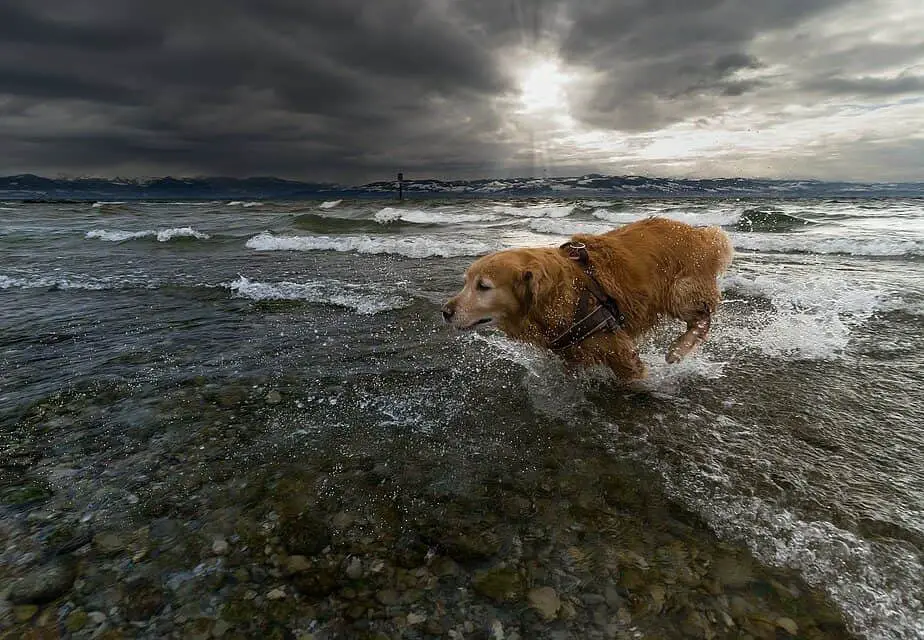
Dogs with thick double coats tolerate swimming in cold water better than dogs with short fur. However, even large, furry animals can develop hypothermia. Your pet should not stay in water longer than a few minutes on days colder than 32°F/ 0°C. Thin or ill dogs, as well as old dogs and puppies, are at a higher risk for developing hypothermia and frostbite.
Some of the hardiest furry breeds are Samoyeds, Huskies, Bernese Mountain Dogs, St. Bernards, Alaskan Malamutes, Akitas, and Shiba Inu. Golden Retrievers are also quite tolerant of low temperatures and swimming in cold water, as long as they are used to cold weather.
Thick, heavy fur protects dogs from getting cold and repels moisture from the skin. 32°F/ 0°C is the freezing threshold, although large bodies of water do not entirely freeze until it gets much colder. Healthy, fit, furry dogs can tolerate even freezing water temperatures, as long as they can get to a warm shelter soon after.
Risk Factors For Hypothermia
Several individual characteristics make dogs of any breed more vulnerable to hypothermia and frostbite.
- Dogs that have a low level of fitness have lower stamina in general, they tend to get cold quickly
- Lack of acclimatization and conditioning: graded exposure to cold temperatures improves tolerance
- Health problems – chronic or acute – put animals at risk
- Old dogs get cold easily due to impaired physiologic responses to low temperatures
- Puppies are extremely vulnerable
- Wet fur is a risk factor even for young and healthy dogs, so your pet should not stay outside long after swimming
- A dog that is not moving much in cold weather, especially after swimming, will get cold
Signs of Hypothermia
Common signs of mild and moderate hypothermia include the following:
- Behavioral changes, for example, nervousness, pacing, refusing to walk
- Picking up and holding up a paw
- Vocalizing in a way that communicates distress
- Pale skin
- Shivering
The signs of progressing hypothermia are the following:
- Weakness and lethargy
- Stiffness of paws and eventually the torso
- Slow breathing
- Labored breathing
- Slow pulse
- Dilated pupils
What to Do If a Dog Gets Cold After Swimming
Large dogs have a normal body temperature in the range of 101.5-102.5 °F / 38.5-39.2 °C.
If body temperature drops down to 90 – 95 °F / 32-35 °C, the dog is mildly hypothermic. A body temperature below 84 °F / 28 °C is a sign of severe hypothermia.
If your dog is severely cold – judging from a thermometer reading or other signs discussed in the section above – take your pet to a veterinarian if possible. Drying the fur should also be a priority when on the way to a veterinarian clinic.
- Dry the dog’s fur with towels
- Bundle your pet with blankets
- Offer warm food and water if your dog can eat and drink, and avoid forcing him/her to eat. If your pet cannot eat and drink and does not resume interest soon, take the dog to a veterinarian
- Avoid placing hot water bottles or heat pads onto the dog’s skin or fur
- Avoid warming the dog up too quickly (by giving him/her a hot bath, for example – doing so is dangerous and could lead to shock and cerebrovascular events
If your pet is behaving abnormally, looks confused, and is very cold, take him or her to a veterinarian as soon as possible.
How To Keep Your Dog Warm In Cold Water
There are several things you can do to improve your dog’s tolerance of cold weather and minimize the odds of hypothermia due to swimming during the cold season:
- Allow your dog to acclimate if your pet is not used to cold temperatures. At first, spend short periods in the cold, gradually increasing the time, as tolerated. If you live in a climate with cold seasons, your pet is more likely to do well in cold weather.
- Make sure your dog has eaten well before taking a swim. A warm meal and water are good options on a cold day, if available.
- It is important to regularly feed your dog good quality food to promote general health and better tolerance to winter weather and temperature extremes in general.
- Let your dog exercise regularly and support graded conditioning.
- Dry your pup’s wet fur as soon as you can.
- Clean the paws of ice and rocks.
- Inspect your pet’s paws and skin so that you can see them for injuries. Early detection of frostbite and other injuries can prevent many health problems for your furry friend.
To Conclude
A healthy double-coated dog might do very well with swimming in cold water and might, frankly, enjoy it. However, regardless of your dog’s breed and the quality of the animal’s fur, pay attention to your pet’s clues.
Even a very healthy, fit dog of a hardy breed might struggle on any given day due to a range of issues. Your dog does need to return to a warm shelter – your home or car – after swimming in cold water. A warm meal is a good way to conclude this form of exercise for your pet.
Recent Posts
A Cavalier and a cat I grew up with mixed-breed rescue cats and dogs in our household, and we shared the compact space of our condo with the animals without issues. I researched to find out what...
Akita Inu Samoyed As Spitz dogs, Samoyeds and Akitas share many similarities. At the same time, the personalities of a typical Akita Inu and a typical Samoyed can be distinctly...

